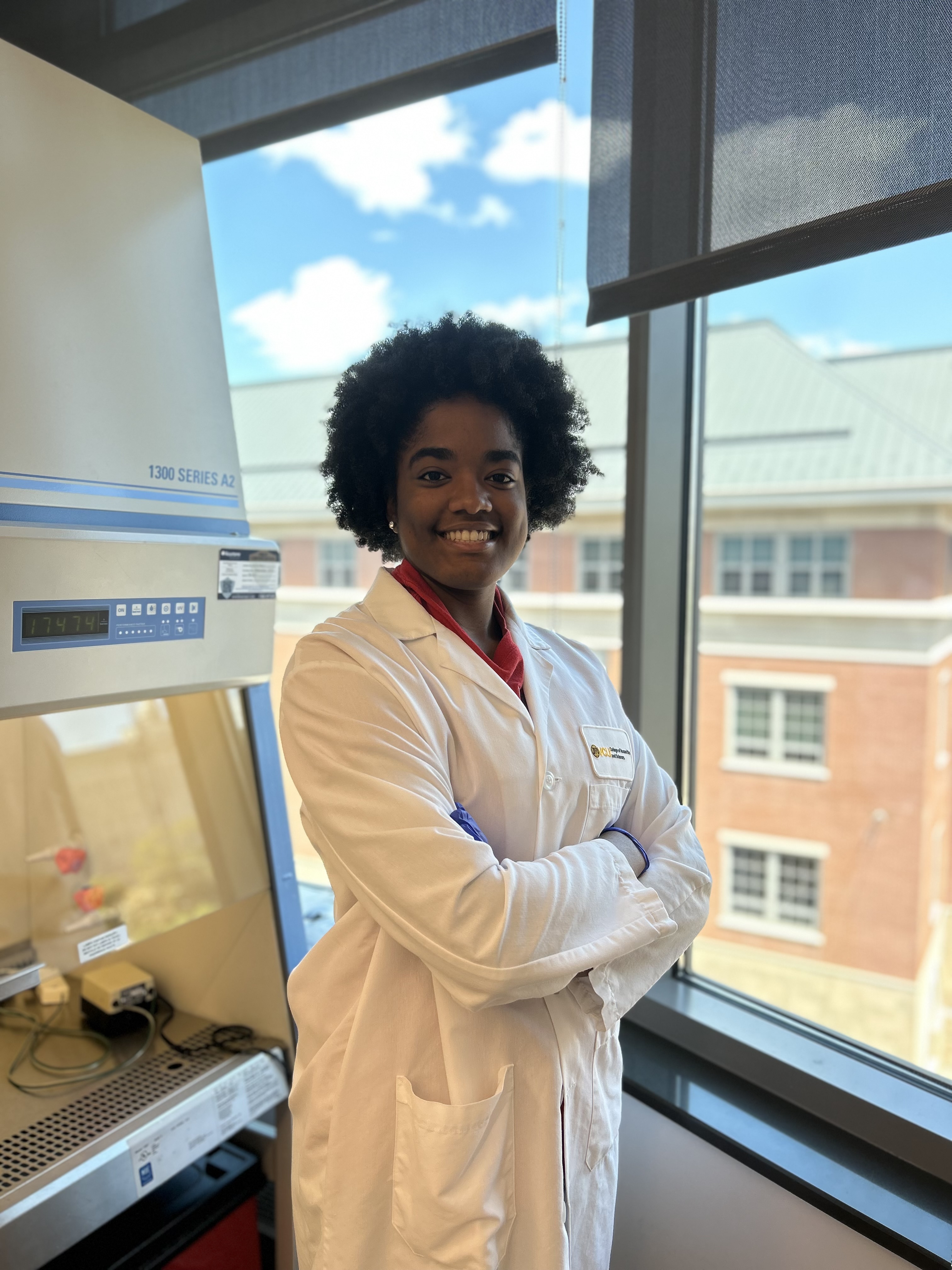Orthopedic and Rehabilitation Engineering
(G-271) Senolytics and Disuse Induced Bone Loss

Gabriella M. Daire (she/her/hers)
Undergraduate researcher
Virginia Commonwealth University- Bone Engineering Science & Technology Lab
Richmond, Virginia, United States
Steven J. Meas
MD/PhD Graduate Student
Virginia Commonwealth University, United States- HD
Henry Donahue
Professor and Chair
Virginia Commonwealth University, United States
Presenting Author(s)
Co-Author(s)
Primary Investigator(s)
Geriatric populations, bed-ridden individuals, and astronauts subjected to long-term space travel, all experience disuse of load bearing bone leading to bone loss. Emerging data suggest that osteocyte senescence contributes to age-related bone loss. Within the bone microenvironment, osteocyte’s primary function is mechanotransduction. They play an essential part in regulating bone metabolism, sensing changes in mechanical load, and translating those changes into biological signals that are integral to bone resorption or formation. While there is compelling evidence for the role of osteocyte senescence in age-related bone loss, it is unclear whether osteocyte senescence plays a role in disuse related bone loss. Senescence occurs from DNA damage by reactive oxidative species, irradiation, telomere attrition, or oncogenic activation. A cell in this state halts proliferation and secretes harmful biological molecules like inflammatory cytokines, chemokines, metalloproteinases, and growth factors (SASP). Senolytics and senomorphics are new avenues to treating cellular senescence and they work by either inhibiting pathways that keep the senescent cell from undergoing apoptosis or by modulating the SASP, respectively. We hypothesize that the administration of senolytics will attenuate disuse-induced bone loss. By subjecting mice to a model of disuse and administering senolytics, the capacity at which senolytics attenuate disuse-induced bone loss can be identified. This has profound implications in clinical practices, as well as space medicine.
Materials and Methods::
6-month-old C57BL/6J male (n=16) and female (n=16) mice were subjected to hind-limb unloading (HLU) or control for three weeks. HLU mice were elevated so their hindlimbs formed an angle of 30º with the wire-mesh bottom. Half of each group were administered either dasatinib + quercetin (5mg/kg and 50mg/kg; D+Q) or vehicle (10%EtOH, 30%PEG400, 60%Phosal-50). There were a total of 4 mice per group. Dasatinib is a tyrosine kinase inhibitor, and quercetin is a citrous flavanol; together they clear senescent cells by inhibiting anti-apoptotic pathways in senescent cells. The D + Q treatment was chosen because it has been shown to decrease senescent cells in humans (Hickson et al., 2019 & Justice et al., 2019) and decrease the amount of senescent osteocytes in aged mice (Farr et al., 2017).
Before and after the 3-week intervention period, microCT (Bruker) was used to measure indices of bone microarchitecture in the mid-diaphyseal cortical bone, metaphyseal trabecular bone and epiphyseal trabecular bone compartments of the left femur. Two-way ANOVA was performed (α = 0.05) with Tukey’s post-hoc test for multiple comparisons. Results were calculated as percent change from baseline. Male and female mice were analyzed separately.
Results, Conclusions, and Discussions::
In male mice, control mice that were treated with senolytics had an increased cortical thickness (Ct.Th) and cortical area (CtAr) compared to control mice treated with vehicle (p < 0.05). There was a main effect of senolytics increasing cortical area fraction (CtAr/TAr, p < 0.05), Ct. Th (p < 0.05) and CtAr (p < 0.05). However, there was no significant difference between HLU mice treated with senolytics or vehicle in the epiphyseal trabecular bone compartment. Control mice that were treated with senolytics had an increased trabecular bone volume (BV/TV, p < 0.05) and trabecular thickness (Tb.Th, p < 0.05). Since there was also an interaction between HLU and senolytics in BV/TV (p < 0.05), there was only the main effect of senolytics increasing Tb.Th (p < 0.01).
In females, there was a main effect of senolytics in epiphyseal BV/TV (p < 0.05) and trabecular number (Tb.N, p < 0.05). There were no other significant terms affected by senolytics or an interaction between HLU and senolytics. This is interesting since, compared to males, females demonstrated a more marked effect of unloading. Female bone indices are not as affected by senolytics, so it is surprising that male bone indices were improved by senolytic administration, however, this effect was not maintained in the context of HLU.
Overall, senolytic administration was shown to have a preventative effect against age-related bone loss in the male control cohort, but not in the females. It is possible that there are other mechanisms contributing to disuse-induced bone loss in this aged group, and senolytics are not the main contributor, and that this mechanism has sex-related differences. Based on recent results from our group, senolytics may be more useful in younger age groups (specifically 3- and 4-month-old mice) experiencing disuse, since an already established senescent profile due to old age may alter the efficacy of senolytics as a treatment. Alternatively, other senolytics may need to be tested to determine if it a class-wide effect or unique to the combination of D+Q and the role of mitochondrion dysfunction investigated.
Acknowledgements (Optional): : First, I would like to thank my principal investigator, Dr. Henry J. Donahue, and my mentor, Steven J. Meas, for their invaluable guidance and support throughout this research process. Additionally, I want to express my gratitude to the Initiative for Maximizing Student Development (IMSD) program for their generous support in my research endeavors.
To the members of the bone engineering science and technology lab here at VCU, thank you for being such a fantastic team!
References (Optional): :
Farr, J. N., Xu, M., Weivoda, M. M., Monroe, D. G., Fraser, D. G., Onken, J. L., Negley, B. A., Sfeir, J. G., Ogrodnik, M., Hachfeld, C. M., LeBrasseur, N. K., Drake, M. T., Pignolo, R. J., Pirtskhalava, T., Tchkonia, T., Oursler, M. J., Kirkland, J. L., & Khosla, S. (2017). Targeting cellular senescence prevents age-related bone loss in mice. Nature Medicine, 23(9), 1072–1079. https://doi.org/10.1038/nm.4385
Hickson, L. T. J., Prata, L. G. L., Bobart, S. A., Evans, T. S., Giorgadze, N., Hashmi, S. K., Herrmann, S. M., Jensen, M. C., Jia, Q., Jordan, K. L., Kellogg, T. A., Khosla, S., Koerber, D. M., Lagnado, A. B., Lawson, D., LeBrasseur, N. K., Lerman, L. O., McDonald, K. P., McKenzie, T. J., . . . Kirkland, J. L. (2019). Senolytics decrease senescent cells in humans: Preliminary report from a clinical trial of Dasatinib plus Quercetin in individuals with diabetic kidney disease. EBioMedicine, 47, 446–456. https://doi.org/10.1016/j.ebiom.2019.08.069
Justice, J. N., Nambiar, A. M., Tchkonia, T., LeBrasseur, N. K., Pascual, R. M., Hashmi, S. K., Prata, L. G. L., Masternak, M. M., Kritchevsky, S. B., Musi, N., & Kirkland, J. L. (2019). Senolytics in idiopathic pulmonary fibrosis: Results from a first-in-human, open-label, pilot study. EBioMedicine, 40, 554–563. https://doi.org/10.1016/j.ebiom.2018.12.052
